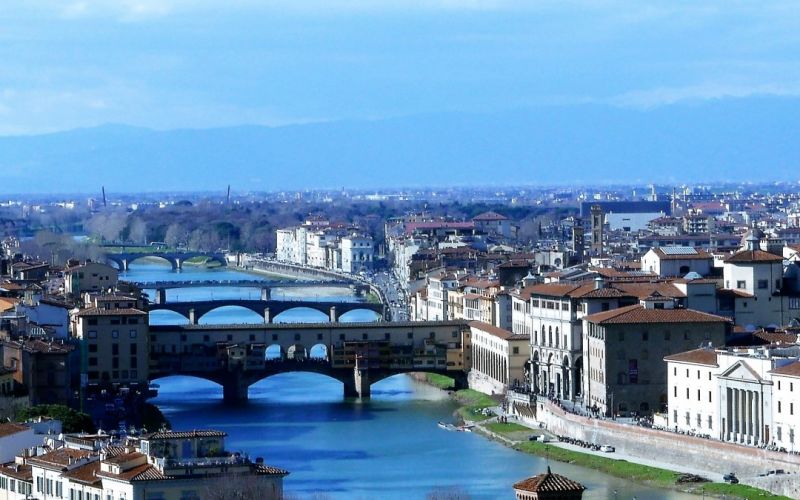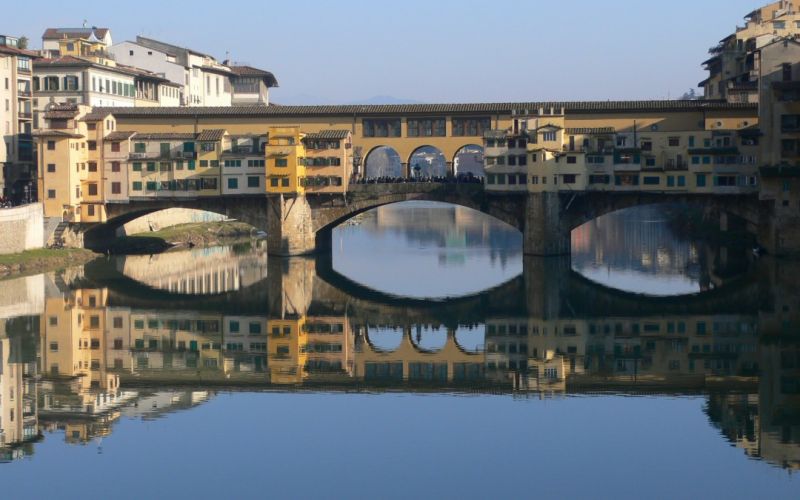The bridges of Florence
Do you know how many bridges there are in Florence, on the Arno River? Just guess … Here is the answer: there are 12, and each one has its history.
The Ponte Vecchio is the only one having escaped from the Second World War destruction. Others, also destroyed during the Second World War, have been rebuilt as they were initially, and new ones have been built recently. Following is the story of 5 of the bridges very close to the Larderel Palace in the center of Florence, a story of floods and reconstructions.
Very close to Palazzo Larderel, the Ponte Vecchio, Florence‘s oldest bridge, is the only one to survive World War II bombing. Built on the narrowest point of the Arno River, its first wooden construction dates back to Roman times. Destroyed in 1333 by a flood, the bridge is rebuilt in stone in 1345 upon three wide arches which still support it. From 1442 to 1593, the bridge was lined with butcher’s shops which threw their waste directly into the Arno river. Ferdinando I de Medici, in the 16th century who couldn’t stand the bad smell reaching into the Vasari corridor, had the butchers replaced by the gold merchants, and it is their beautiful shops and jewels!
Next to the Ponte Vecchio, downstream, stands the Ponte Santa Trinità , that leads to Via Tornabuoni where the Palazzo Larderel stands. Built by the famous Frescobaldi family in 1253, it was a wooden bridge. It was also swept away by the big 1333 flood. A new bridge with 5 arches was constructed in stone by Taddeo Gaddi, also destroyed by a flood in 1557, and again replaced by Ammannati. Four statues representing the seasons were added in 1608 at the occasion of the wedding of Cosimo II de Medici. The bridge was destroyed by German bombing in 1944. A temporary “Bailey” bridge was built for temporary use by the British army and the bridge was fully reconstructed in 1957 exactly as it was with original stones raised from the Arno.
Ponte alla Carraia (meaning the carts’ bridge) is the next one downstream after the Ponte Santa Trinità, also built in wood in 1218, was also destroyed by a flood, rebuilt, again damaged in 1557, and again rebuilt by Ammannati. At the end of the 19th century, it was enlarged to allow the carriages to pass. Blown up by the German Army while retreating in 1944, it was rebuilt under its current structure in 1948.
Upstream of the Ponte Vecchio stands the Ponte alle Grazie was originally built in 1237, and withstood all great floods. But it was also destructed by the German army. The current five-span bridge was inaugurated in 1957
Ponte San Niccolo, also upstream after the Ponte alle Grazie, was originally an iron bridge commissioned by the Grand Duke Leopoldo in in 1837/38. It was destroyed in 1844 by another flood and replaced by a suspension bridge also mined by the German army. It was rebuilt in 1949 in a single arched reinforced concrete bridge.













